
TIME IS OF THE ESSENCE
In law school and then in the legal world, there was a phrase we used: TIME IS OF THE ESSENCE. The legal phrase is used to specify the time period which one party must complete its contractual obligations to the other, or else face consequences. During my coaching days, I often used this same phrase with my hitters – TIME IS OF THE ESSENCE when the pitcher releases the pitch.

TIMING is a term of art with specific meanings in hitting world. Timing has multiple layers as it relates to hitting:
- There is the hitter’s perception of speed or the “effective velocity” of the pitch;
- When the hitter makes the decision/choice to start or time his/her pelvis load based on when the pitcher starts the delivery;
- The timing of the hitter’s visual processing and the window of when he/she must subconsciously perceive/decide/guess – “ball or strike”, “fast or slow”, “in or out”, “up or down”, “yes or no”, etc.;
- Rate of force development or the time it takes for a hitter to “get the swing off”;
- Getting your foot down early is FEAR OF TIME;
- Getting one-legged or sitting on a pedestal and waiting to see the ball before you move is TRYING TO FOOL OR CHEAT TIME;
- Starting late or staying motionless and then having to panic and over swing/spin with your torso and shoulders in order to catch up is WASTING TIME;
- Hitting is HARD; and pitching will always dominate hitters and hitters will always struggle if they cannot figure out timing adjustments, hitting plans & approaches, and proper, consistent mechanics to be ON TIME;
- A hitter’s start is “FREE TIME” i.e. not done under any time constraints;
- The hitter’s swing plane/path and rate of force development ADDS TIME to his/her decision making process;
- MILLISECONDS ARE WORTH MILLIONS TO A M.L.B. HITTER;
- Timing paired with visual processing is the GOLD STANDARD.
The hitter is in TOTAL CONTROL of how & WHEN he/she loads the pelvis and integrates the spine. Step 1 is finding a process that creates a consistent set up every time the hitter gets into the batter’s box.
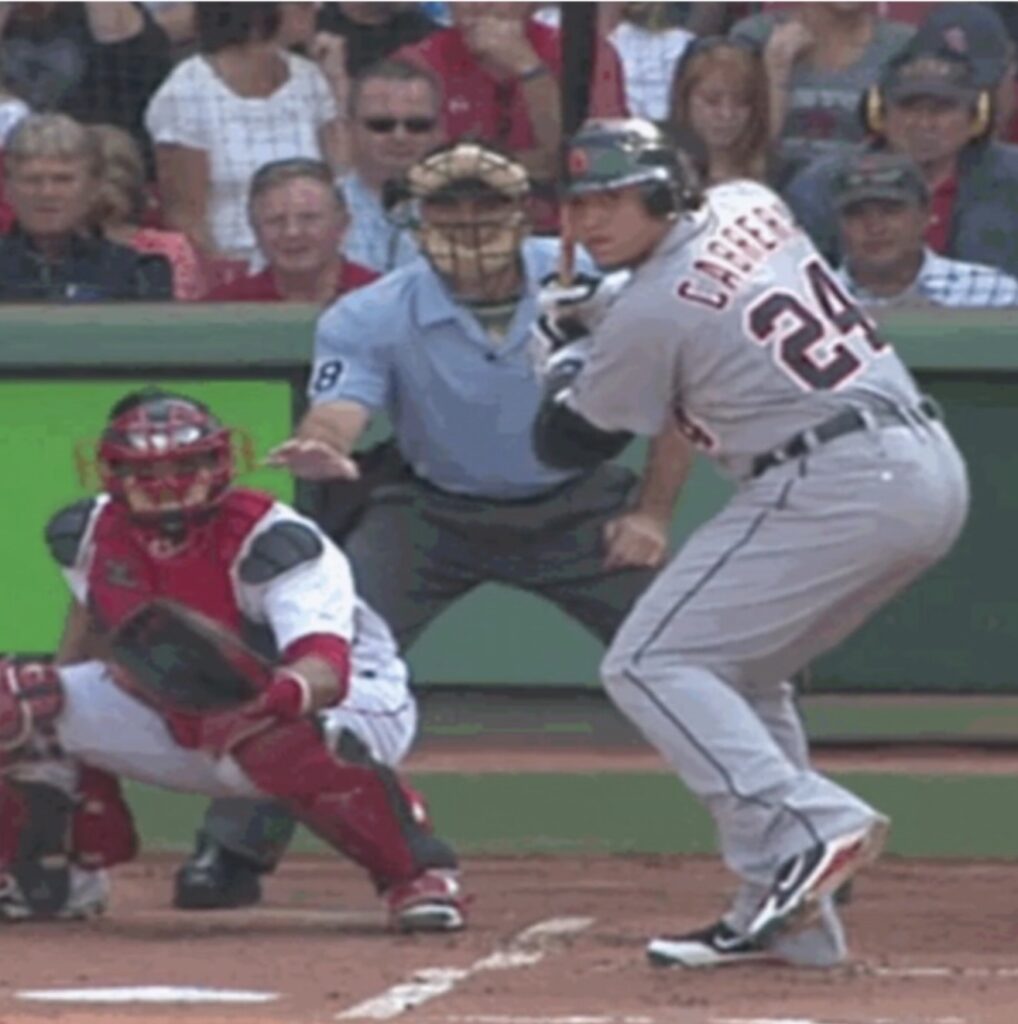
What does BEING ON TIME mean to a baseball hitter? I’ve heard it defined as the hitter’s ability to know HOW & WHEN to initiate the transition or transfer from the “loading phase” into the “launch phase” to have enough time to get the bat around to make hard contact with the pitched ball.
Does the body transition from loading to launch by changing directions? Or going from maximum stretch to snap, like a rubber band? Does this occur when the hitter gets his/her stride foot down?
Instructors who believe in PROXIMAL TO DISTAL know these are the absolute WRONG QUESTIONS TO ASK. Changing directions or transitioning from phase to phase or focusing on the “distal foot” is NEVER GOING TO GET ANYBODY ON TIME.
Creating and transferring energy in a flash and under extreme time constraints is not a final exam question – it’s a skill and an art that belongs to the most talented athletes on earth.
The pitcher/pitch has a “TIME” component and the hitter/swing mechanics has a “TIME” component; the pitcher is throwing a small, round ball and the hitter is swinging a heavy round wooden bat – and they have to be SYNCHED UP IN ORDER TO BE ON TIME. This is the hardest skill to perform in all of sports.
As a hitter, you need as close to 100% of your potential bat speed/exit velocity in the shortest amount of time to be successful. Swinging the bat slower to get on time is never the right option. Also, waiting longer to start the pelvis loading and then trying to swing in the same time no matter if the pitch is fast or slow is not optimal either. Just like, starting the pelvis loading at the same time but trying to coil/moving the middle “slower” is also not a good idea.
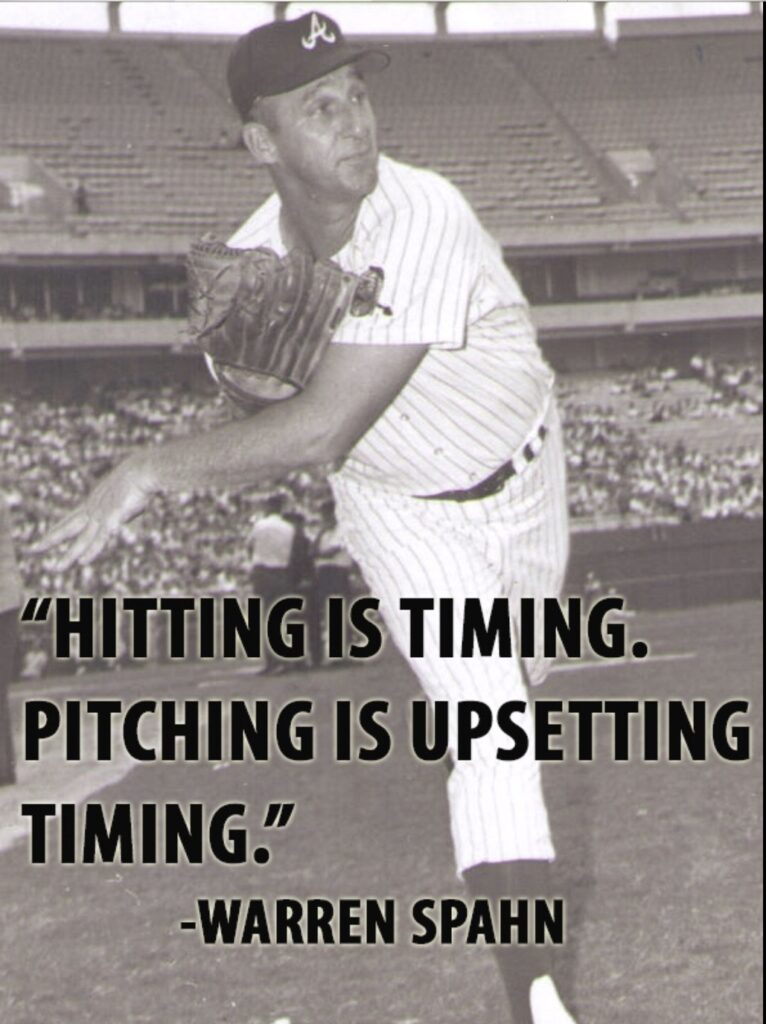
THE TIMELINE
There are two very important parts of BEING ON TIME: (1) visual processing by the hitter of the pitch, i.e. the hitter’s reaction/recognition TIME, AND (2) the hitter’s actual swing mechanics & rate of force development (the TIME it takes to get the sweet spot of the barrel to the baseball).
The swing has a TIMELINE. The pitch has a TIMELINE. The hitter has to MATCH THE SWING TIME WITH THE PITCH TIME.
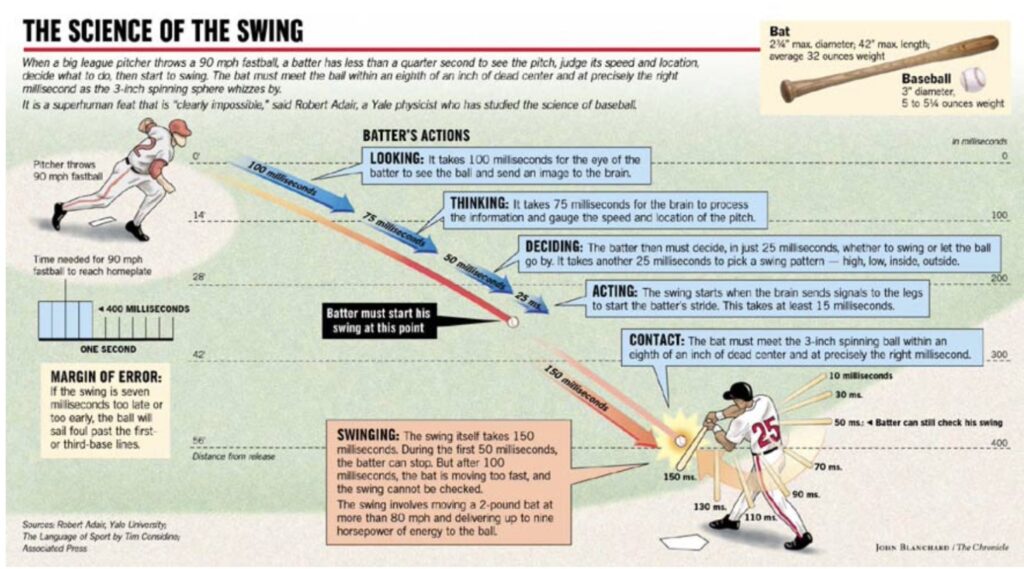
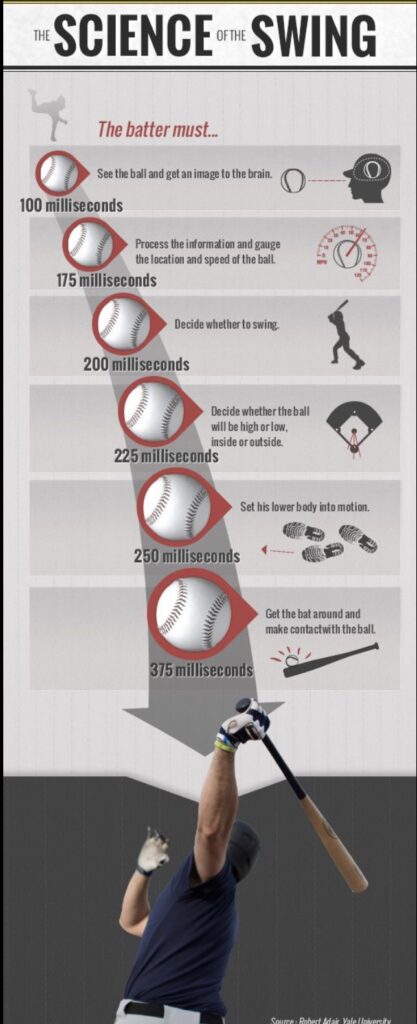
HINGE EARLY, COIL LATE
I like the cue, “HINGE EARLY, COIL LATE”. Basically, the cue is illustrated by showing video and still frames of great hitters who start the loading of their pelvis about the same time that the pitcher breaks his/her hands to start their delivery; and subsequently, “coils” the pelvis and “moves the middle” about at the pitcher’s release of the pitch.
I wish it was that simple and that cue would solve all timing problems, but it does not. I’ve seen many hitters who HINGE EARLY & COIL LATE who cannot catch up to velocity up and in. I’ve been around hitters who struggle when they face pitchers who throw SLOW, SLOWER, & SLOWEST. The challenge is to figure out WHY? Is it because of a:
- timing problem;
- approach problem or having the wrong plan;
- rate of force development problem;
- visual recognition issue;
- functional swing mechanics flaw?
- or a combination of some or all of the above?
IT’S PROXIMAL TO DISTAL
How a hitter “moves” matters. Do they SWAY? Are they PROXIMAL TO DISTAL? Are they worried about “when do I get my foot up”, “how high should my leg lift be”, “when do I get my foot down”, “am I dancing with the pitcher while I am on deck”?
What’s the relevance of when the hitter’s front foot gets down? Does that indicate the end of coil?
With lumbopelvic-spine driven hitters, monitoring and detecting movement variations is simple because you don’t worry about the “distal” legs – you manage your TEMPO & TIMING via hinging & coiling & rotating your pelvis with an integrated spine.
People ask all the time:
- “when do I get my foot down?”
- What part of the body goes FIRST to launch?
- Are the wrists still cocking or do I get a running start with the barrel?
- Do I twist & counter rotate the upper body back as far as possible while the stride foot gets down to toe touch to get maximum stretch?
- Is there a particular point where the “transition moment” between load and launch happens?
- Is it where the upper body is turned farthest away from the lower body to create maximum stretch?
- Is it like snapping a rubber band by using the stretch-shortening cycle to whip the barrel into contact?
ANSWER: NO.
Again, if you understand PROXIMAL TO DISTAL and you believe in the control by the lumbopelvic-spine complex, you don’t worry about your “distal” legs and you know & feel that TEMPO & TIMING are managed by the loading/hinging, coiling/move the middle and rotation of your pelvis with a integrated and stable spine (“posture”).
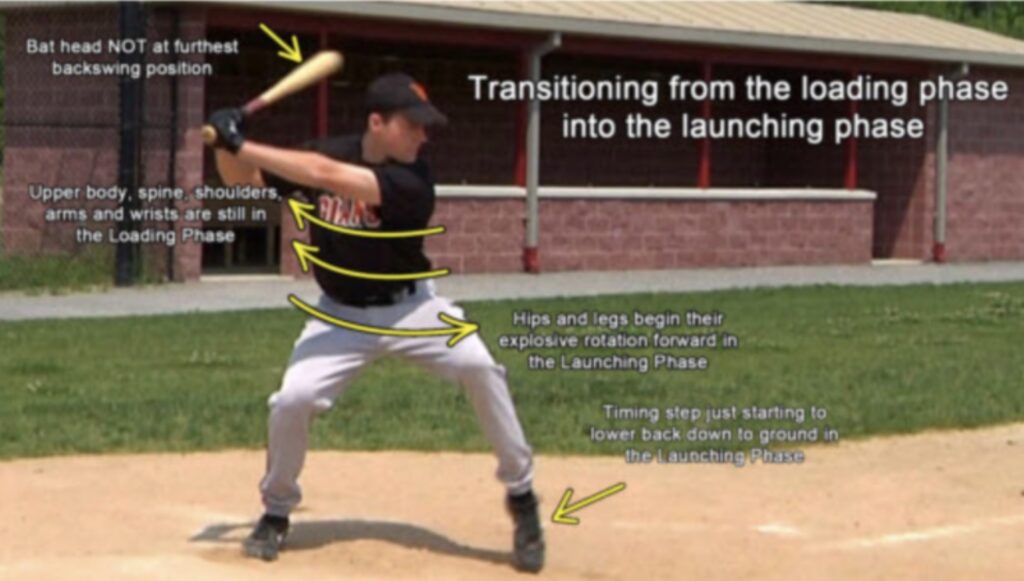
CREATING A BUFFER
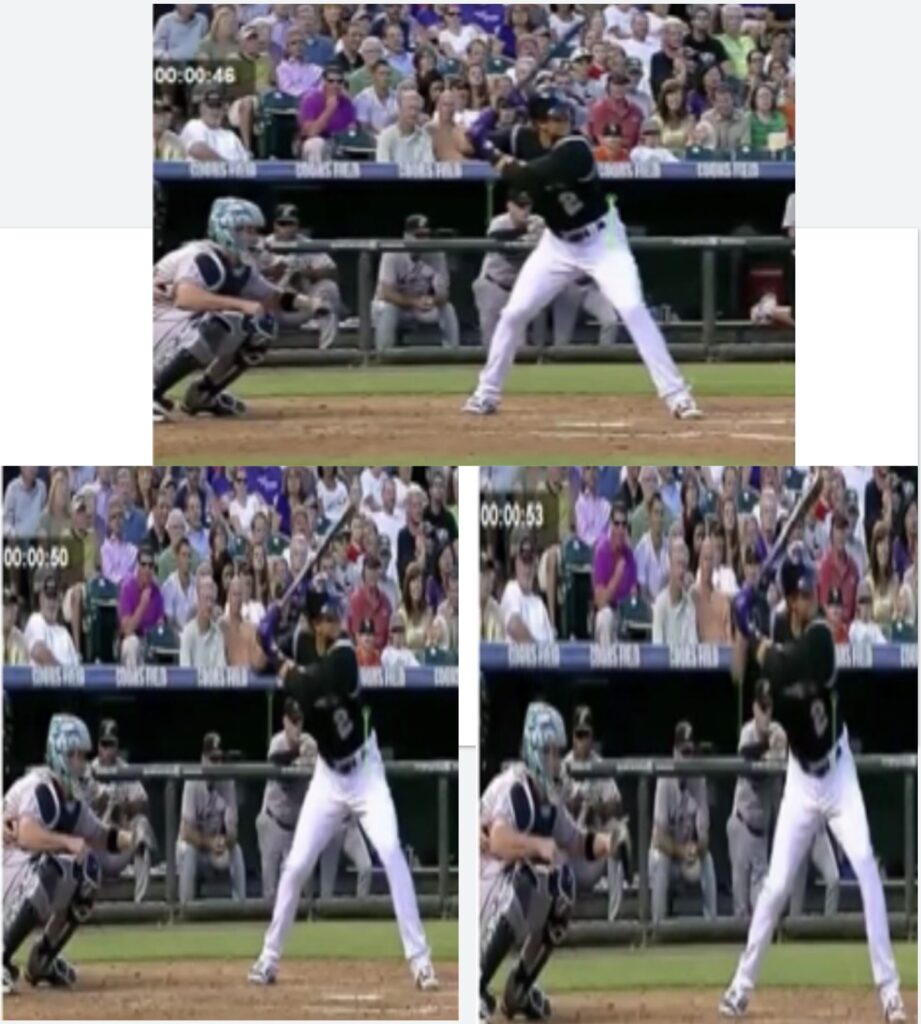
All of the above 3 frames are from the same at bat of Troy Tulowitzki hitting a change-up for a home run. And all of the 3 frames are AFTER TOE TOUCH. Take notice of the “frame/time counter” above the catcher’s head at 00:0:46 in the top photo, at 00:00:50 in the bottom left photo, and 00:00:53 in the bottom right.
Despite Tulo’s stride foot being firmly planted on the ground in all 3 frames above, his pelvis is still coiling (maintaining and increasing tension) AND he is still “moving his middle” while keeping a stable spine/“posture”.
In frames 00:00:46 and 00:00:50, his pelvis has NOT started to “rotate”; he continues to coil; his hands and barrel are still “back”; and his front leg is bent at the knee.
In frame 00:00:53 on the bottom right, you can notice the orientation of his pelvis is now “slightly different” as his hands and barrel are still “back”. What happened in those 3/100ths of a second? You can see the overlap of coil (his hands and barrel are still back) and the beginnings of him launching his swing (his pelvis is now slightly open).
How is Tulo starting to open his pelvis? It is not a change of direction; in other words, it is not a turn in the transverse plane. What is he doing “under the hood” to initiate the launch? How can he create the rate of force development in a time constraint of 12/100th of a second with enough power created within to hit the change-up for a home run?
In order to create the “buffer”, he has to know and have confidence that his “transfer mechanics” are quick and explosive enough.
Awesome body awareness synched with his visual recognition of an off-speed pitch.
COMPARE FASTBALL vs. CHANGE-UP
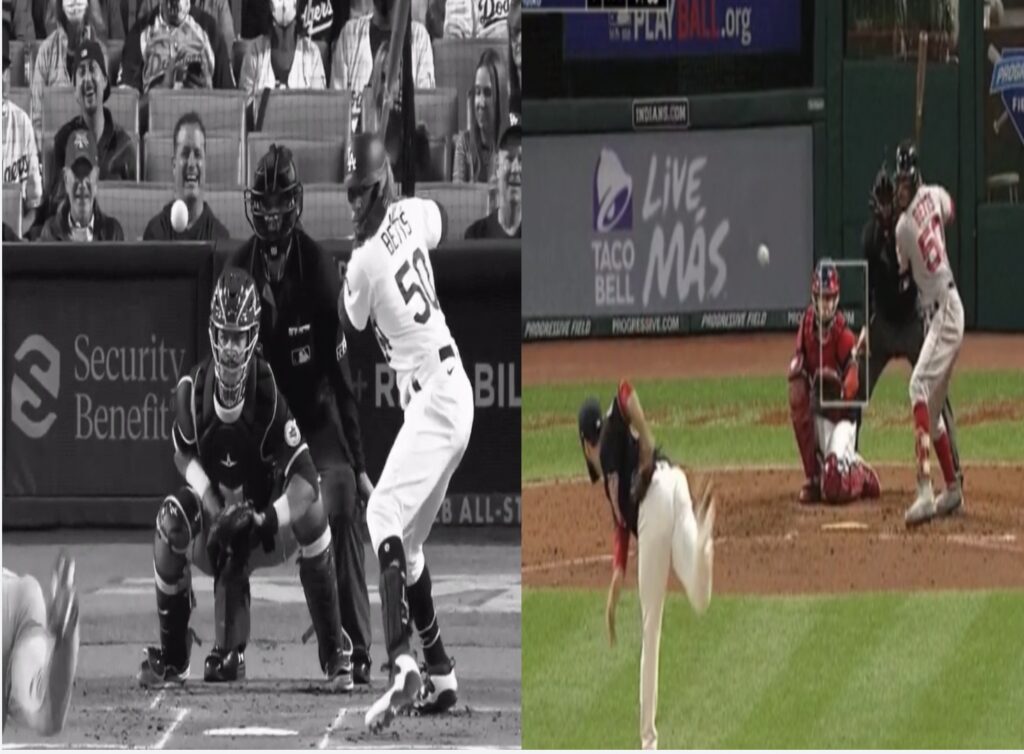
Here is a side by side comparison to look at where Mookie Betts’ pelvis load is right before toe touch. Change-up in the photo on the left (you can see the “hump” in the vertical plane of the pitch) and fastball in the photo on the right. At this point, Mookie is continuing to load, coil and move his pelvis as he picks up information to recognize pitch type.
Very similar movement patterns, posture, etc. up to this point. No major adjustment yet in either sequence or tempo. No difference in where his center of mass is either. In other words, on the left is the change-up and he is not “hanging back” or “striding slower” or “pausing” or whatever. He is not staying one-legged either and tilting rearward, even on a change-up. His stride (coil/moving the middle) is the SAME for the fastball and the change-up/off speed.
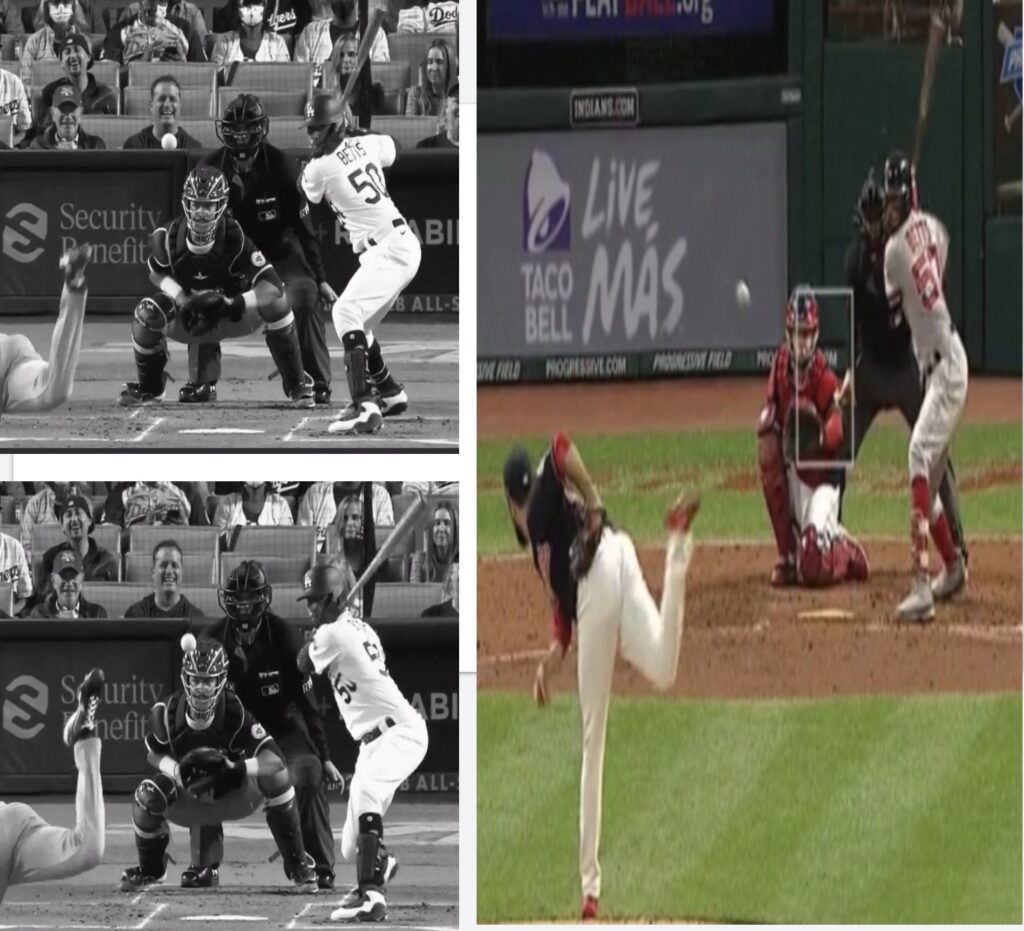
At the landmark of toe touch is where you can notice the swing adjustment between hitting velocity versus a change-up. On the right against velocity, Mookie “opens his hips” and “rotates into toe touch”. On the upper left against a change-up, his hips are still “closed”, as he maintains his “tension” and is still creating “elasticity” via coil/moving the middle.
The BUFFER Mookie creates (between the upper left and lower left photo) to be able to adjust to the change-up is a result of his ability to maintain and even increase elasticity AFTER TOE TOUCH as he recognizes the pitch type. This is the sign of a very good hitter who has the VISUAL PROCESSING SKILLS, proper hitting mechanics and the right hitting plan/approach.
Compare the frame on the upper left to the frame on the lower left. Just like with Tulo, there is only about a 3/100ths of a second between the two frames; the ball seems like it is in the exact same spot. But you can notice the orientation of his pelvis is now “slightly different” as his hands and barrel are still “back”. What happened in those 3/100ths of a second? You can see the overlap of coil (his hands and barrel are still back) and the beginnings of him launching his swing (the orientation of his pelvis).
How is Mookie starting to open his pelvis &/or change its orientation? It is not a change of direction; in other words, it is not a turn in the transverse plane. It’s not a drastic movement of the barrel (ie snapping it rearward). It is very imperceptible but so obvious. If you compare Mookie on the right (hitting the fastball) to Mookie on the bottom left (hitting the change-up), the way he initiates the launch of his swing is the SAME MOVEMENT PATTERN.
The same exact “transfer mechanics” move are made by both Mookie and Tulo, AND at precisely the same exact times. And these transfer mechanics and precise timing show up over and over again with most all great hitters.
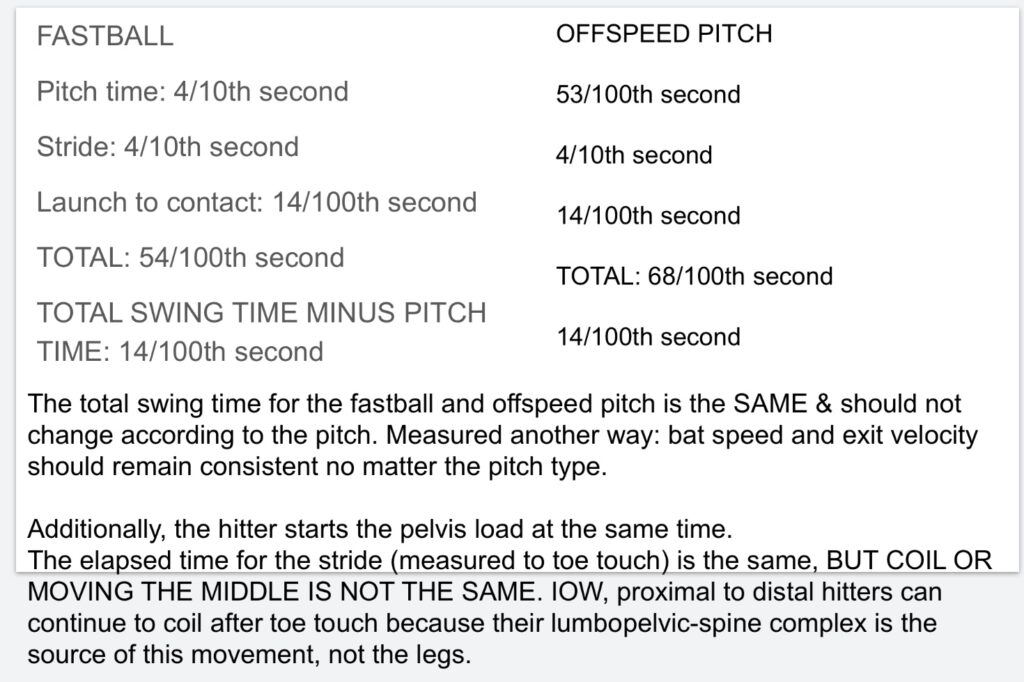
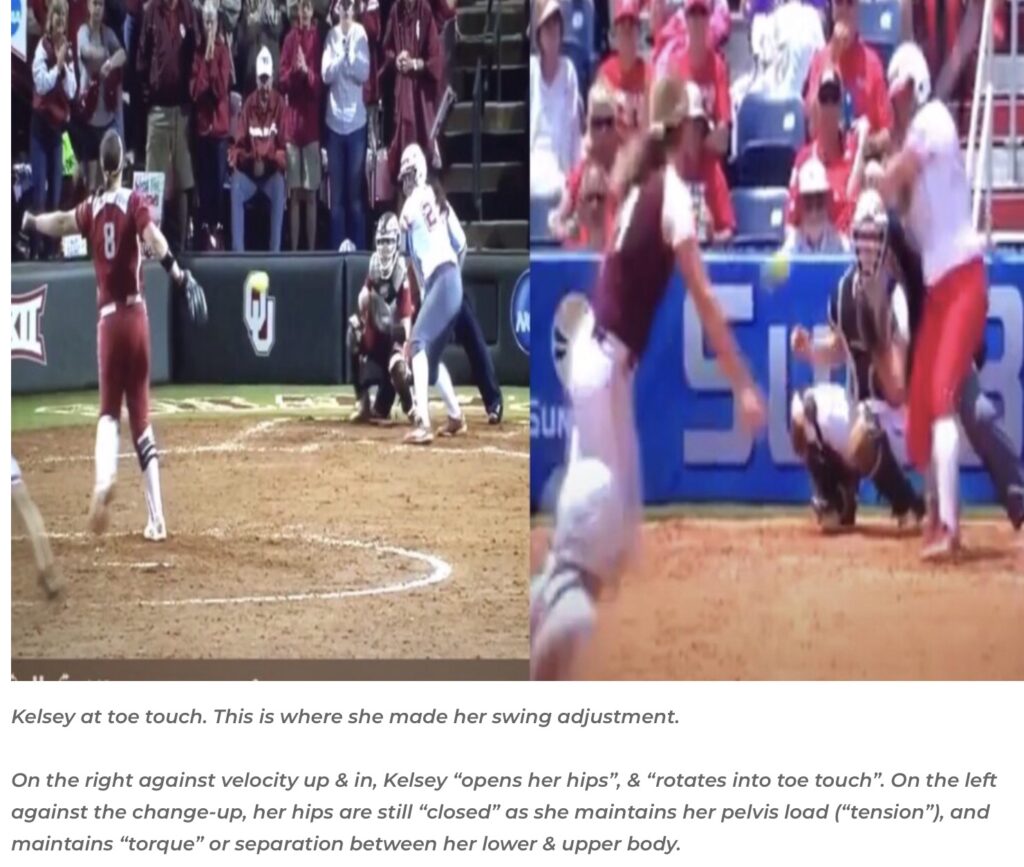
She is using the same “buffer” adjustments as Tulo and Mookie showed above BUT she did it under greater time constraints (softball is released from 35 feet away with more drastic pitch differentials (velocity up & in between 64-68 m.p.h. and off-speed/change-up 48-55 m.p.h.).
She uses the same “transfer mechanics” too. She initiates the launch of her swing THE EXACT SAME WAY as Tulo and Mookie with the same rate of force development (12/100th of a second) and with home run power – actually hitting the change-up further than the riseball. Impressive. Great athlete/hitter benefitting from the right training/learning environment.
BE ON TIME BY CREATING ADJUSTABILITY
Elite hitters all have a BUFFER ZONE – timing component – trained, practiced and built into their swings to give them some room to adjust and BE ON TIME. Great hitters are incredibly accurate with the barrel into contact on time. Those hitters have the ability to either delay the launch of the swing but still maintain & increase elasticity when the ball is not yet at the “magic 10-15 foot marker” or to launch earlier if the ball shows up faster/sooner. Great hitters create their rate of force development quickly and powerfully with precise transfer mechanics.
PURSUE EXCELLENCE & WIN THIS PITCH!
About the Author

Mike Lotief coached 17 successful years as either the head softball coach or co-head softball coach with his wife Stefni Whitton Lotief at the University of Louisiana from 2002-2017 with an overall coaching record of 731-176 (80.6 winning percentage). Every season, the Ragin Cajuns softball team advanced to the NCAA tournament and also advanced to three (3) Women’s College World Series (2003, 2008, 2014) and from 2012-2016 advanced to five (5) straight NCAA Super Regionals. Coach Lotief produced over 40 All American selections and his 2017 team lead the nation in scoring and was ranked in the Top 10 in home runs, slugging percentage, on base percentage.
The coach is a cancer survivor (twice) and was the first person in the U.S. to receive the Pro Trach device. Mike and Stefni spearheaded and raised the funding to build the new softball stadium in 2009 and the new softball indoor hitting facility in 2015. They are proud parents to Chelsea, who played softball and graduated from the Univ. of Louisiana in 2018, and Andrew, who is a junior at Louisiana studying Mechanical Engineering.
Previous Articles in this Series
- The Mental Swing Attractors: Failure Cannot Break You (Nov. 11, 2021)
- Training Insights: “Swing Attractors” by Coach Mike Lotief… the Flaws of Pelvic Loading (Nov. 9, 2021)
- The Mental Swing Attractors: Push Yourself… You Don’t Have to Be #1 to BE #1! (Nov. 4, 2021)
- Training Insights: “Swing Attractors” by Coach Mike Lotief… Pelvis Loading, Part 2—The Planes of Movement (Nov. 2, 2021)
- The Mental Swing Attractors: Remove the Rope from Your Ankle & Get Rid of the Limiting Beliefs! (Oct. 28, 2021)
- Training Insights: “Swing Attractors” by Coach Mike Lotief… Pelvis Loading, Part 1—It’s All in the Hips (or Somewhere Deep Below) Oct. 26, 2021
- The Mental Swing Attractors: Champions are Developed by Devotion & Discipline! (Oct. 21, 2021)
- Training Expertise: “Swing Attractors”… the Secrets of Power Hitting by Coach Mike Lotief (Oct. 19, 2021)
More About Mike Lotief
- Why Michael Lotief is a Legendary Coach? by Jay Patel
- The Secret To Michael Lotief’s Success. By Jay Patel
- Michael Lotief Fights for Rajin’ Cajuns by Graham Hays ESPN
- Michael Lotief: Taking His Sport to New Heights by Neha Kapoor
- For the Love of the Game: A Look at Ragin’ Cajun Softball’s Power Couple
- How Louisiana-Lafayette’s Michael Lotief Develops Hitting Gems by Graham Hays ESPN
